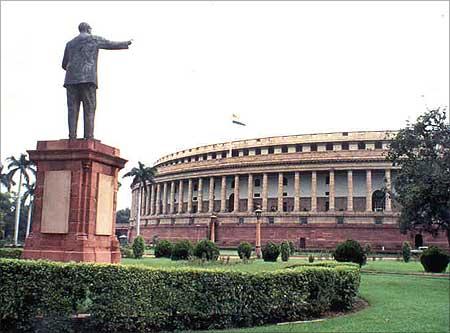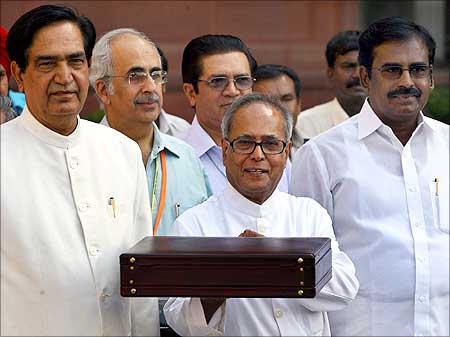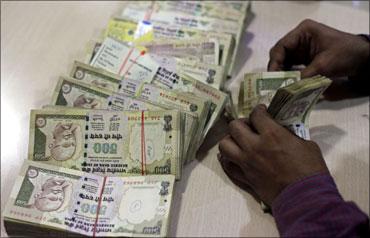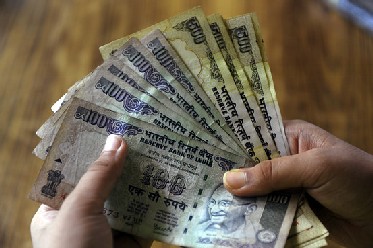 | « Back to article | Print this article |
How Indian policy makers made a mess of the finances
It is customary at this time of the year to look back and assess how the year set to end in a few days went by.
For the government's economic policy makers, one word should describe 2011 quite aptly: overestimation.
Indeed, government leaders -- ministers and their senior secretaries -- should have no difficulty in putting together a long list of overestimations that caused no end of surprises to the nation during the year.
Topping that list will be their estimate of the Indian economy's growth.
How gung-ho were our leaders about the Indian economy's growth potential at the start of 2011!
Click NEXT to read further. . .
How Indian policy makers made a mess of the finances
Finance Minister Pranab Mukherjee projected a growth rate of a little over nine per cent in his Budget for 2011-12, presented on February 28.
Questions on the feasibility of achieving a nine per cent growth rate in the current year were raised even then, but they were all treated with utter disdain.
It is not that signs of an imminent slowdown were not visible then.
The problem was that economic policy makers in the government refused to believe that the Indian economy's growth rate could slow down as a result of a financial crisis in major economies of the world and particularly in Europe.
Click NEXT to read further. . .
How Indian policy makers made a mess of the finances
What may have kept their hopes alive was the unusual spike in industrial output growth in a few of the early months of 2011, particularly in March, and sustained exports growth that continued until September.
Exports growing by around 30 to 40 per cent in the first half of 2011-12 bolstered their optimism on economic growth.
The first big surprise for them was when export growth slipped in October and November.
Worse, the government realised that there was an overestimation of export numbers, thanks to a data entry error.
Click NEXT to read further. . .
How Indian policy makers made a mess of the finances
By this time, the gross domestic product or GDP growth figures for the first two quarters of the current financial year had come in, sending out clear signals that projections of a nine per cent growth rate were clearly unfounded.
However, the bigger surprise was that in spite of such signals, there was considerable reluctance on the part of the government to revise the growth projections downwards.
It is only now that the government's policy makers are admitting to a growth rate of seven per cent or thereabouts.
Considering the pace at which the various sectors of the economy are slowing down, even this figure may turn out to be an overestimate by the end of the year.
Click NEXT to read further. . .
How Indian policy makers made a mess of the finances
However, nobody from the government is venturing out to present what certainly will be a more realistic number on India's economic growth.
Inflation rate projections during the current year also showed how government policy makers were prone to making incorrect estimates.
At the start of 2011, almost everybody associated with economic policy making in the government predicted that the inflation rate would decline considerably by the end of the year.
What they meant was that the double-digit inflation level, estimated on the rise in the wholesale price index, would come down to a more manageable level of five or six per cent.
Click NEXT to read further. . .
How Indian policy makers made a mess of the finances
Periodically, new targets were put out to indicate the date by when the inflation rate would be brought down, and almost invariably those targets were missed.
It was only at the fag end of the year that the government managed to get a grip on inflation.
This, too, came as a surprise.
While the government projected a fall in the food inflation rate to below three per cent by November, the actual data showed that food inflation was hovering around two per cent.
Click NEXT to read further. . .
How Indian policy makers made a mess of the finances
Fiscal deficit projections, too, suffered from the same malaise and threw up several surprises.
Mr Mukherjee presented a Budget with a fiscal deficit for the current year projected to rule at 4.6 per cent of GDP.
This was an ambitious target since it was clear right then that achieving that figure would depend on a sharp squeeze on expenditure, revenue receipts from disinvestment and a reduction in subsidy payments to oil companies.
Mr Mukherjee has managed to rein in expenditure, but his assumptions on disinvestment proceeds and subsidy payments to oil companies have gone completely haywire.
Click NEXT to read further. . .
How Indian policy makers made a mess of the finances
The stock market has turned bearish and the government has so far managed to raise only about Rs 1,400 crore (Rs 14 billion) from sale of its stake in public sector undertakings.
The disinvestment proceeds target for the current year was Rs 40,000 crore (Rs 400 billion).
The government is now trying many innovative ways to meet the shortfall, but such attempts may not help it meet the gap.
On the oil subsidies front, the government managed to decontrol petrol prices, but other petroleum products continue to be subsidised by the oil companies.
Click NEXT to read further. . .
How Indian policy makers made a mess of the finances
This has put pressure on government finances, making it even more difficult for Mr Mukherjee to meet the fiscal deficit target for the current year.
It is difficult to estimate the cost the Indian economy may have to incur because of these wrong estimates at the start of the year.
A more realistic estimate of the key macroeconomic targets can certainly help in better management of the economy.
Can we hope that, in 2012, the government will be a little more realistic in making projections for the economy?









